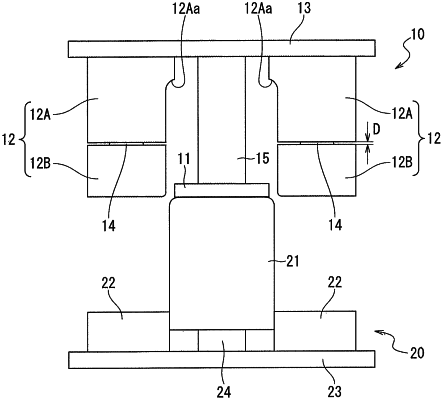| CPC B21D 22/26 (2013.01) | 3 Claims |

|
1. A press form device for performing a first step of bend-forming a base sheet or a material to be processed obtained by applying bending or drawing to a base sheet beforehand into a hat cross-sectional shape having a top sheet portion and right and left vertical wall portions continuous to both sides in a width direction of the top sheet portion, having one vertical wall portion linearly extending along a longitudinal direction and the other vertical wall portion having a curved portion projecting to a side of the one vertical wall portion along the longitudinal direction, and not having a flange portion and a second step of applying compression by a preset compression amount in a direction along a press direction to the vertical wall portions in a formed state by the first step,
the preset compression amount being set in a range of 2% or more and 6% or less of heights of the vertical wall portions,
the press form device comprising:
a punch and a pad configured to sandwich the top sheet portion between the punch and the pad in a sheet thickness direction;
bending blades disposed on sides of the punch and the pad and configured to bend-form the vertical wall portions; and
stoppers facing the bending blades in the press direction and configured to constrain end portions of the material to be processed, wherein
the pad and the bending blades configure an upper die,
the punch is supported by a first cushion component elastically expandable and contractible in the press direction,
the bending blades each have an upper die component having a shoulder portion and a lower die component vertically divided in an arbitrary location below the shoulder portion of the upper die component and capable of facing the vertical portion of the vertical wall portion having the press part shape and by a face crossing with the press direction in a middle of the press direction and disposed facing each other in the press direction with an interval equal to the compression amount to be applied and a second cushion component interposed between the upper die component and the lower die component at the arbitrary location below the shoulder portion of the upper die component, configured to maintain the interval, and contractible in the press direction at a predetermined pressure or more, and
cushion pressure of the second cushion component is lower than cushion pressure of the first cushion component and has such cushion pressure that the second cushion component does not contract during the bend-forming of the vertical wall portions in the first step.
|